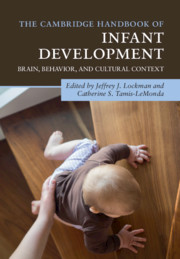Book contents
- The Cambridge Handbook of Infant Development
- The Cambridge Handbook of Infant Development
- Copyright page
- Dedication
- Contents
- Illustrations
- Contributors
- Preface
- Part I Foundations
- Part II Perceptual Development
- Part III Cognitive Development
- 12 Infant Memory
- 13 Infant Physical Knowledge
- 14 Infant Categorization
- 15 Early Knowledge About Space and Quantity
- 16 Infant Learning in the Digital Age
- Part IV Action
- Part V Language
- Part VI Emotional and Social Development
- Index
- References
16 - Infant Learning in the Digital Age
from Part III - Cognitive Development
Published online by Cambridge University Press: 26 September 2020
- The Cambridge Handbook of Infant Development
- The Cambridge Handbook of Infant Development
- Copyright page
- Dedication
- Contents
- Illustrations
- Contributors
- Preface
- Part I Foundations
- Part II Perceptual Development
- Part III Cognitive Development
- 12 Infant Memory
- 13 Infant Physical Knowledge
- 14 Infant Categorization
- 15 Early Knowledge About Space and Quantity
- 16 Infant Learning in the Digital Age
- Part IV Action
- Part V Language
- Part VI Emotional and Social Development
- Index
- References
Summary
Media is so embedded in the lives of infants and toddlers that it should no longer be considered a nuisance variable that could affect development but rather a fundamental part of the context in which development occurs. Parents, educators, and policy makers often remain polarized in the adoption of digital devices, either acting with extreme concern or overly optimistic enthusiasm (Lauricella, Blackwell, & Wartella, 2017). Researchers have recognized that it is not only the amount of time with which children were interacting with these technologies but also how and what they were engaging with that predicted learning and other outcomes (Lauricella et al., 2017). However, accurately assessing the content and context of media use during early childhood has been problematic, with some methods leading to overestimation and others to underreporting of media exposure (Vandewater & Lee, 2009).
Keywords
Information
- Type
- Chapter
- Information
- The Cambridge Handbook of Infant DevelopmentBrain, Behavior, and Cultural Context, pp. 435 - 466Publisher: Cambridge University PressPrint publication year: 2020
References
Accessibility standard: Unknown
Why this information is here
This section outlines the accessibility features of this content - including support for screen readers, full keyboard navigation and high-contrast display options. This may not be relevant for you.Accessibility Information
- 3
- Cited by
